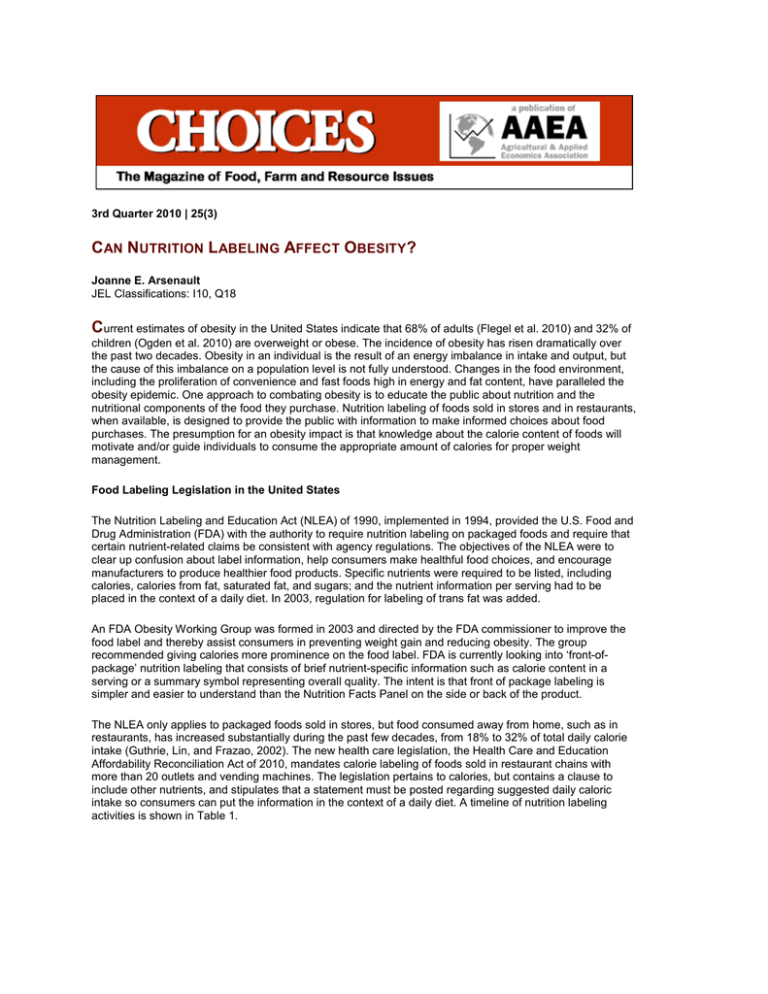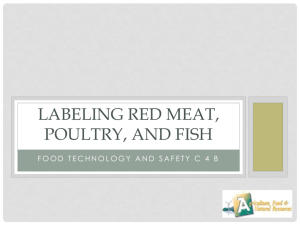C N L
advertisement

3rd Quarter 2010 | 25(3) CAN NUTRITION LABELING AFFECT OBESITY? Joanne E. Arsenault JEL Classifications: I10, Q18 Current estimates of obesity in the United States indicate that 68% of adults (Flegel et al. 2010) and 32% of children (Ogden et al. 2010) are overweight or obese. The incidence of obesity has risen dramatically over the past two decades. Obesity in an individual is the result of an energy imbalance in intake and output, but the cause of this imbalance on a population level is not fully understood. Changes in the food environment, including the proliferation of convenience and fast foods high in energy and fat content, have paralleled the obesity epidemic. One approach to combating obesity is to educate the public about nutrition and the nutritional components of the food they purchase. Nutrition labeling of foods sold in stores and in restaurants, when available, is designed to provide the public with information to make informed choices about food purchases. The presumption for an obesity impact is that knowledge about the calorie content of foods will motivate and/or guide individuals to consume the appropriate amount of calories for proper weight management. Food Labeling Legislation in the United States The Nutrition Labeling and Education Act (NLEA) of 1990, implemented in 1994, provided the U.S. Food and Drug Administration (FDA) with the authority to require nutrition labeling on packaged foods and require that certain nutrient-related claims be consistent with agency regulations. The objectives of the NLEA were to clear up confusion about label information, help consumers make healthful food choices, and encourage manufacturers to produce healthier food products. Specific nutrients were required to be listed, including calories, calories from fat, saturated fat, and sugars; and the nutrient information per serving had to be placed in the context of a daily diet. In 2003, regulation for labeling of trans fat was added. An FDA Obesity Working Group was formed in 2003 and directed by the FDA commissioner to improve the food label and thereby assist consumers in preventing weight gain and reducing obesity. The group recommended giving calories more prominence on the food label. FDA is currently looking into ‘front-ofpackage’ nutrition labeling that consists of brief nutrient-specific information such as calorie content in a serving or a summary symbol representing overall quality. The intent is that front of package labeling is simpler and easier to understand than the Nutrition Facts Panel on the side or back of the product. The NLEA only applies to packaged foods sold in stores, but food consumed away from home, such as in restaurants, has increased substantially during the past few decades, from 18% to 32% of total daily calorie intake (Guthrie, Lin, and Frazao, 2002). The new health care legislation, the Health Care and Education Affordability Reconciliation Act of 2010, mandates calorie labeling of foods sold in restaurant chains with more than 20 outlets and vending machines. The legislation pertains to calories, but contains a clause to include other nutrients, and stipulates that a statement must be posted regarding suggested daily caloric intake so consumers can put the information in the context of a daily diet. A timeline of nutrition labeling activities is shown in Table 1. Impact of Food Labeling on Consumer Behavior For food labeling to impact consumers’ health and weight status, consumers must use the information. They must first read the label, understand the information and how to use it, and then make decisions about their food consumption based on the information. According to the 2008 Health and Diet Survey conducted by FDA, 54% of consumers reported often using the food label when purchasing a food item for the first time. There are indications of increased use of food label information in the years immediately after the implementation of NLEA. In the 1990 Health and Diet Survey, 30% of consumers said they changed their minds about buying a food product because they read the nutrition label. By the end of 1995, approximately one year after the food labeling legislation went into effect, 48% had done so (Levy and Derby, 1996). That figure has remained stable, with 49% of respondents in the 2008 survey reporting changing their minds about purchasing a product based on reading the nutrition label. Information on nutrient content of foods alone does not necessarily affect dietary behavior. Food choices are influenced by many factors, and consumers must be motivated to use the information for their health. Awareness of diet and health relationships is an important motivational factor for dietary behavior. A USDA food intake survey conducted in the 1990’s asked participants about both food intake and nutrition knowledge and found that those who were aware of health problems associated with saturated fat and cholesterol consumed less of those nutrients (Variyam, 1999). Some studies have shown that people who are aware of diet-disease relationships use food labels to guide their food choices, and that food label use is associated with better dietary intake choices. A survey in Washington State found that belief in the importance of a low-fat diet and knowledge of the association between diet and cancer strongly predicted food label use, and that food label use was significantly associated with lower fat intake (Neuhouser, Kristal, and Patterson, 1999). In a nationally representative survey conducted in 1994-1996, food label use was associated with higher overall dietary quality as measured by the USDA’s Healthy Eating Index (Pérez-Escamilla and Haldeman, 2001). More recently, individuals in the National Health and Nutrition Examination Survey (NHANES), 2005-2006, who had a chronic condition such as diabetes, hypertension, or hyperlipidemia reported reading food labels more than those without any of these conditions—71% versus 60% for the sample (Post et al. 2010). Among individuals with one or more of these conditions, those who read food labels consumed more fiber and less sugar than those who did not read labels. Another study using the same NHANES dataset reported that overweight individuals were more likely to use food labels (Lewis et al. 2009). One objective of the NLEA was to encourage manufacturers to produce healthier food products. The NLEA allowed for nutrition content claims on products, such as “low-fat” or “reduced-fat,” if the product met specific criteria. Considerable increases in the number and sales of fat-modified foods were documented within the year after the NLEA went into effect (Levy and Derby, 1996). However, these products are not necessarily lower in calories than similar foods with higher fat content because the fat is often replaced with sugar. Therefore, consumption of these products does not necessarily lead to lower overall energy intake. Potential Impacts of Labeling on Health and Obesity Impacts of nutrition labeling on health outcomes is more difficult to assess directly. When the NLEA was enacted, an FDA economic impact analysis estimated that the food label could save up to $26 billion in health care costs over the next 20 years based on estimated reductions in heart disease and cancer due to dietary improvements (FDA, 1993). Only one study to date has since estimated an impact of NLEA on obesity and health-associated cost savings (Variyam and Cawley, 2006). The study examined data before and after NLEA from an annual national health survey, the National Health Interview Survey, which asks about food label use and body weight. Body mass index (BMI) increased over the time period and label use remained steady. However, label users gained less BMI than nonusers, although the difference was only significant among non-Hispanic white females. It is unclear why the effect was only significant among that segment of the population. The study also estimated the potential economic impact of NLEA, based on estimated benefits from reduced BMI. The estimated value of benefits of NLEA among non-Hispanic white women was $166 billion over a 20-year period due to lower mortality risk, reduced medical expenditures, lower absenteeism, and increased productivity. Some estimates of impacts on obesity have also been made with regard to nutrition labeling of restaurant menus. A recent study of pre and post calorie labeling of Starbucks’ menu items estimated a 6% reduction in calories per sales transaction, and further projected a decrease in long-term body weight of less than 1% (Bollinger, Leslie, and Sorensen, 2010). An impact assessment in Los Angeles County estimated that restaurant menu labeling could decrease the annual weight gain of residents by 41%, based on estimates from other reports that 10% of restaurant patrons select reduced-calorie meals as a result of menu labeling with an average calorie reduction per meal of 100 kcal (Kuo et al. 2009). Studies assessing the impact of nutrition labeling on obesity should be viewed with some caution. First, they are too few in number to make any definitive conclusions. Moreover, they are based on many assumptions often obtained from one study and extrapolated to a larger population. The optimal scientific study design would be a randomized trial where one group is exposed to nutrition labeling and a control group is not exposed, and both groups are followed over a long-term period to determine use of labeling, dietary intake, and body weight. Therefore, other factors affecting food intake and obesity would be evenly distributed among the two groups and differences in the outcomes could be attributed to labeling. It is likely that individuals with specific characteristics use labels to guide their daily food consumption, and these could be identified and accounted for in further extrapolations to predict impacts on a national population level. In reality, this type of study would not be feasible in a real world setting; therefore, observational studies of label users and nonusers in various populations that control for other factors related to label use and health outcomes should be considered. New options for labeling, such as front-of-package and restaurant menu item calorie information, should increase consumers’ awareness of their calorie consumption. Menu labeling may result in reductions in fat and calorie content of menu items through recipe modification or reduction of portion sizes served. It is hard to imagine that a consumer would not be affected to some degree by knowledge that a selected entrée contains their entire recommended calorie intake for the day. However, the effect of menu labeling on consumers remains to be seen. One could argue that the entire U.S. population has been exposed to nutrition labeling of foods for almost two decades and obesity is rising. Likewise, if obesity starts to decrease after mandatory menu labeling goes into effect, this does not infer causality. There are many other factors influencing obesity and a wide variety of efforts are being undertaken to tackle the obesity problem. Nevertheless, nutrition labeling of foods and menu items is important because the consumer has a right to know what they are purchasing and consuming. Some motivated consumers will use information on the label or menu to guide their food choices. At the population level, nutrition labeling is just one of many efforts that will be needed to combat the obesity epidemic. For More Information Bollinger, B., Leslie, P., Sorensen, A.T. (2010). Calorie posting in chain restaurants. NBER working paper 15648. Cambridge, Mass.: National Bureau of Economic Research. Food and Drug Administration (FDA). (1993). Regulatory impact analysis of the final rules to amend the food labeling regulations. Federal Register, 58, 2927-2941. Flegel, K.M., Carroll, M.D., Ogden, C.L., Curtin, L.R. (2010). Prevalence and trends in obesity among US adults, 1999-2008. Journal of the American Medical Association, 303(3), 235-241. Guthrie, J.F., Lin, B-H., Frazao, E. (2002). Role of food prepared away from home in the American diet, 1977-78 versus 1994-96: Changes and consequences. Journal of Nutrition Education and Behavior, 34(3), 140-150. Kuo, T., Jarosz, C.J., Simon, P., Fielding, J.E. (2009). Menu labeling as a potential strategy for combating the obesity epidemic: A health impact assessment. American Journal of Public Health, 99(9), 1680-1686. Lewis, J.E., Arheart, K.L., LeBlanc, W.G., Fleming, L.E., Lee, D.J., Davila, E.P., Cabán-Martinez, A.J., Dietz, N.A., McCollister, K.E., Bandiera, F.C., Clark, J.D. (2009). Food label use and awareness of nutritional information and recommendations among persons with chronic disease. American Journal of Clinical Nutrition, 90(5), 1351-57. Levy, A.S., and Derby, B.M. (1996). The Impact of the NLEA on consumers: Recent findings from FDA’s food label and nutrition tracking system. Washington, D.C: Food and Drug Administration, Consumer Studies Branch, Center for Food Safety and Applied Nutrition. Neuhouser, M.L., Kristal, A.R., Patterson, R.E. (1999). Use of food nutrition labels is associated with lower fat intake. Journal of the American Dietetic Association, 99(1), 45-53. Ogden, C.L., Carroll, M.D., Curtin, L.R., Lamb, M.M., Flegel, K.M. (2010). Prevalence of high body mass index in US children and adolescents, 2007-2008. Journal of the American Medical Association, 303(3), 242249. Pérez-Escamilla, R., and Haldeman, L. (2001). Food label use modifies association of income with dietary quality. Journal of Nutrition, 132(4), 768-772. Post, R.E., Mainous, A.G., Diaz, V.A., Matheson, E.M., Everett, C.J. (2010). Use of the nutrition facts label in chronic disease management: Results from the National Health and Nutrition Examination Survey. Journal of the American Dietetic Association, 110(4), 628-632. Variyam, J.N. (1999). Role of demographics, knowledge, and attitudes in America’s eating habits: Changes and consequences. Agricultural Information Bulletin 750, E. Frazao, ed. Washington DC: US Department of Agriculture, p 281-294. Variyam, J.N., and Cawley, J. (2006). Nutrition labels and obesity. NBER working paper 11956. Cambridge, MA: National Bureau of Economic Research. Joanne E. Arsenault (jarsenault@rti.org) is a Nutrition Policy Analyst in the Food and Agricultural Policy Research Program, RTI International, Research Triangle Park, North Carolina. The author thanks Chung-Tung (Jordan) Lin at the Food and Drug Administration for providing information and helpful comments. © 1999-2010 Choices. All rights reserved. Articles may be reproduced or electronically distributed as long as attribution to Choices and the Agricultural & Applied Economics Association is maintained.



